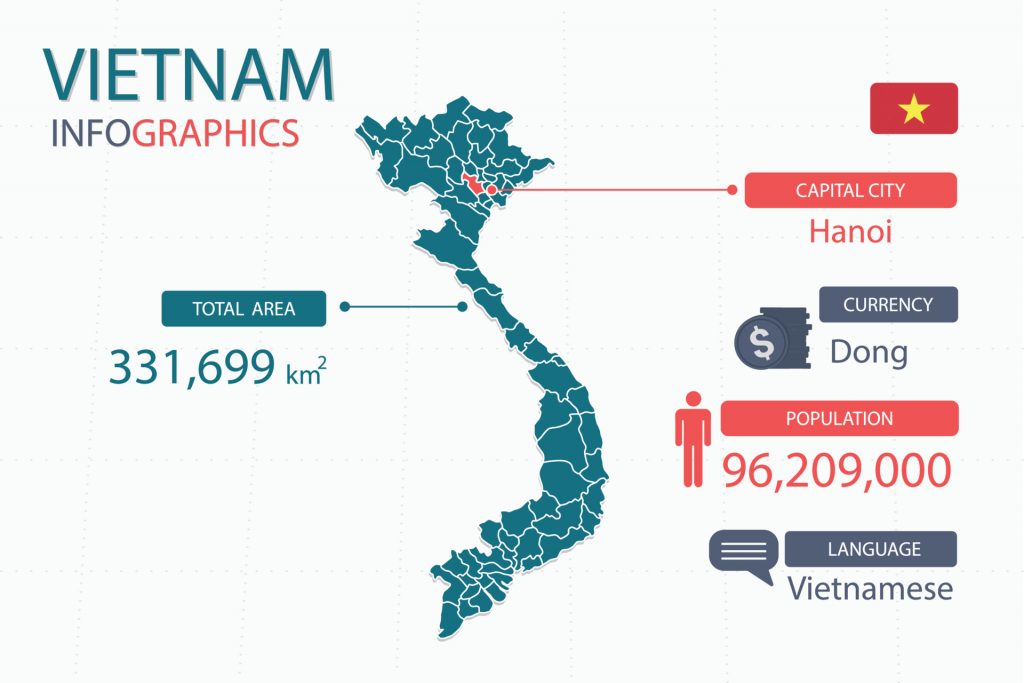The origins of the Vietnamese Language
The Vietnamese language is a language primarily spoken in Vietnam by approximately 75 million speakers. It is also spoken by large Vietnamese communities outside of Vietnam such as communities found in China, in North America, and certain European countries. Interestingly, it is also officially recognized as a minority language in the Czech Republic. In its current form, it is a tonal language that uses the Latin alphabet. There are two main varieties of Vietnamese spoken, Northern Vietnamese and Southern Vietnamese, with differences in terms of pronunciation, writing, and vocabulary.
In terms of language family classification, Vietnamese used to be categorized as a Mon-Khmer language, with languages such as Khmer, the language of Cambodia. Recently, however, more similarities in structures with the Muong language have led some linguists to classify it as a Viet-Muong language, as some consider the two to be more genealogically related. It is also heavily influenced by the Chinese language, with much vocabulary stemming from the thousand or so years the Chinese occupied Vietnam. In addition, a French influence is also notable in vocabulary from its time as a French colony. During France’s colonization of Vietnam, French was used as the official language of business and education, and such a shift made its presence known in the language as well. With such a history, and depending on the linguistic theoretical outlook, related languages may be Muong, Khmer, and various varieties that are spoken in Cambodia, Vietnamese, and some bordering regions of China. Modern Chinese and French can also be considered distant relatives because of their heavy influence.

Grammatically, Vietnamese follows the subject-verb-object order. It is also a tonal language where a tone may change the meaning of the word. Northern Vietnamese contains a total of six tones, while other varieties, including the Southern variety, include five or fewer tones. In addition, there is a large number of pronouns that are used that indicate age, gender, and at times, social status. Compared to a language like English, for example, where only the pronouns he and she exist, Vietnamese differentiates between older and younger persons, gender, and more. Vietnamese does not have any conjugations or inflexions for its verbs. There is no marking for concepts such as gender, tense, case, and number. Therefore, some people believe it to be simpler to learn in that regard.
Written Vietnamese has had an interesting history as, for the majority of the time, it was written using systems based on Chinese characters. At first, it used Chinese characters that were represented in Chinese classical texts. As time went on, logograms that stemmed from Chinese, but exclusively used in Vietnamese were developed. These contained a number of characters that did not exist in the original Chinese writing system and were used to represent Vietnamese sounds.
Only recently, during French colonization, did the systems based on Chinese characters disappear. These were replaced by Latin-based characters. During this time, there were about four competing systems. This is mainly due to the combination of French and Chinese influences, as well as a lack of standardization in the realms of education, governmental administration, and other areas of life and culture. However, during the French colonization period, influences of China and the indigenous cultures of Vietnam were phased out. This colonial push for cultural dominance also influenced the formation of the Latin-based writing system that would eventually be used up until now, and as a result, the standardization of its spelling system. As a result, the current script is based on spelling reforms made before, during and after independence, spanning about twenty years between the mid-1950s and 1970s.
The script contains traditional Latin letters, such as the ones used in English, some modified letters, as well as marks that signify the tone of a syllable. The modified letters represent sounds that may exist only in Vietnamese. Words are separated by a space and are written left to right, similar to most other Western scripts. Punctuation is very similar to most Western European languages. Chinese based characters are still rarely used, mainly in terms of traditional expressions, such as within the realm of artistic works.
Currently, it is the official and national language of Vietnam. Due to culinary reasons, many words originating in Vietnam are also used in other languages abroad. These include pho, the noodles that the Vietnamese are so well known for, as well as banh mi, the Vietnamese sandwich. These words are especially prevalent where Vietnamese communities exist abroad, such as in parts of North America. Otherwise, it is a language that is mostly used in Vietnamese communities around the world. These, of course, include the Vietnamese in Vietnam, but also in large communities in Cambodia, in North America, in France, and other regions where Vietnamese may have migrated, especially after the Vietnamese civil war.
VEQTA can provide you with a perfect Vietnamese translator for your Vietnamese translation, English to Vietnamese translation and Vietnamese to english translation for the your targeted locale. Our translations to Vietnamese are created with your target audience in mind to meet your expectations.
If you need to translate Vietnamese – Get in touch today!
A dedicated team of Vietnamese translators who combines Experience, Specialized Subject Matter Expertise with Translation Practices to deliver quality second to none.
Vietnamese Subject Expertise
Vietnamese Translators
Vietnamese Editors
Vietnamese Copywriters
Vietnamese Reviewers
Vietnamese Voice dubbing
Vietnamese Subtitling
Vietnamese Transcription


